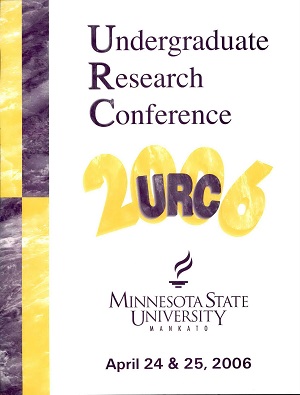Geochemical Assay of Natural and Anthropogenic Processes of a Large Prairie Pothole Lake
Location
CSU North Ballroom
Start Date
25-4-2006 10:00 AM
End Date
25-4-2006 12:00 PM
Student's Major
Chemistry and Geology
Student's College
Science, Engineering and Technology
Mentor's Name
Trent P. Vorlicek
Mentor's Department
Chemistry and Geology
Mentor's College
Science, Engineering and Technology
Second Mentor's Name
Bryce W. Hoppie
Second Mentor's Department
Chemistry and Geology
Second Mentor's College
Science, Engineering and Technology
Description
Numerous natural and anthropogenic processes contribute to lake water quality. Lake Titloe, Sibley County, Minnesota, is one of the few remaining large shallow prairie pothole lakes in south central Minnesota. The lake possesses highly impaired water quality. Water samples and sediment cores • were collected during abundant algal blooms and ice over conditions to characterize the concentration and position of nutrients and other contaminants. Elevated concentrations of total suspended solids (TSS) and total suspended volatile solids (TSVS) indicate the notable presence of both organic and inorganic particulates in the water. In situ analyses of the water show high concentrations of phosphate and nitrate within the water column, but further investigation by means of ion chromatography (IC) of filtered samples reveals greatly reduced concentrations of phosphate and nitrate. Covariance of high phosphate and nitrate concentrations with TSS and TSVS implies the organic and inorganic binding of the anions to the organic and inorganic particles. In the same analyses, the IC shows high concentrations of sulfate and chloride during both sampling periods in both the water column and sediment core and thus implies the system is well mixed. High concentrations of sulfate and chloride often correspond to strong anthropogenic contributions to the lake water. Outcomes of this research include: refined methods for future analysis of the water and sediment samples, streamlining the measurement of TSS and TSVS, and continued method development with the IC.
Geochemical Assay of Natural and Anthropogenic Processes of a Large Prairie Pothole Lake
CSU North Ballroom
Numerous natural and anthropogenic processes contribute to lake water quality. Lake Titloe, Sibley County, Minnesota, is one of the few remaining large shallow prairie pothole lakes in south central Minnesota. The lake possesses highly impaired water quality. Water samples and sediment cores • were collected during abundant algal blooms and ice over conditions to characterize the concentration and position of nutrients and other contaminants. Elevated concentrations of total suspended solids (TSS) and total suspended volatile solids (TSVS) indicate the notable presence of both organic and inorganic particulates in the water. In situ analyses of the water show high concentrations of phosphate and nitrate within the water column, but further investigation by means of ion chromatography (IC) of filtered samples reveals greatly reduced concentrations of phosphate and nitrate. Covariance of high phosphate and nitrate concentrations with TSS and TSVS implies the organic and inorganic binding of the anions to the organic and inorganic particles. In the same analyses, the IC shows high concentrations of sulfate and chloride during both sampling periods in both the water column and sediment core and thus implies the system is well mixed. High concentrations of sulfate and chloride often correspond to strong anthropogenic contributions to the lake water. Outcomes of this research include: refined methods for future analysis of the water and sediment samples, streamlining the measurement of TSS and TSVS, and continued method development with the IC.
Recommended Citation
Johnson, Benjamin J.. "Geochemical Assay of Natural and Anthropogenic Processes of a Large Prairie Pothole Lake." Undergraduate Research Symposium, Mankato, MN, April 25, 2006.
https://cornerstone.lib.mnsu.edu/urs/2006/poster-session-D/2



